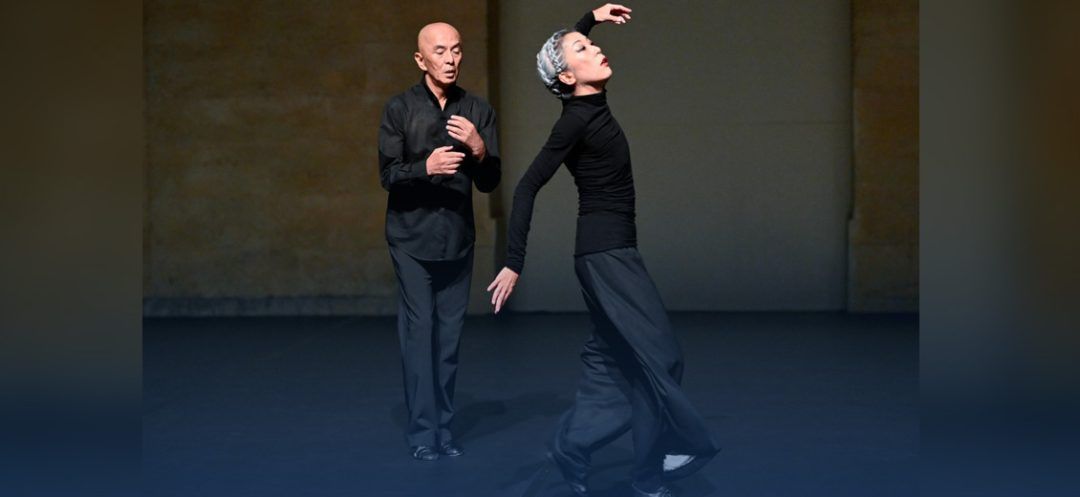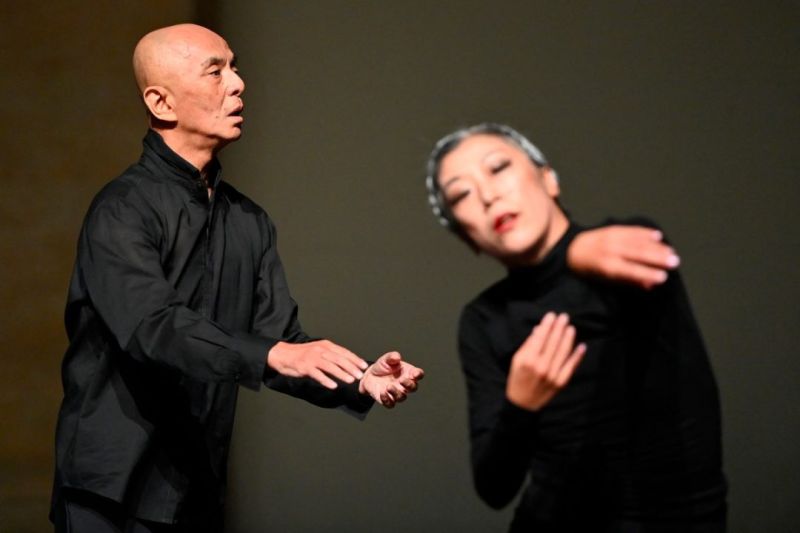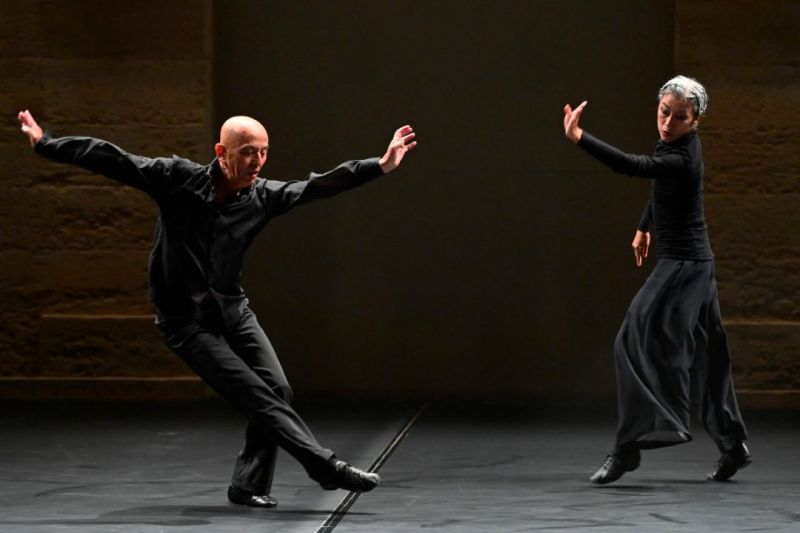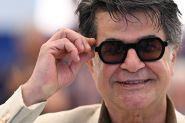
©Photo by Sylvain Thomas/AFP
Japanese choreographer Saburo Teshigawara presented “Voice of Desert,” a piece for five dancers blending delicacy and brutality, at the Montpellier Danse Festival.
On Saturday evening, the Montpellier Danse Festival hosted an exceptional creation by Japanese choreographer Saburo Teshigawara. With “Voice of Desert,” he offered the audience a piece for five dancers, marked by striking contrasts, within the open-air theater setting of the Agora.
When Saburo Teshigawara enters the stage, his body does not impose itself; it merges into the atmosphere. His movements, fluid and interspersed with finely controlled bursts, exude fragility. Together with his long-time partner, Rihoko Sato, they embody delicacy. “This piece was created to touch the souls of human beings,” the choreographer explains. “’Voice of Desert’ outlines, through the body, our inner voices, those of our body, our spirit.”
 Photo by Sylvain Thomas/AFP
Photo by Sylvain Thomas/AFP
Born in 1953 in Tokyo, Saburo Teshigawara initially studied visual arts and classical dance. Convinced of the need for in-depth learning before embarking on creation, he forbade himself from producing his first piece before the age of 30. “I decided that I needed to study music, writing, materials, elements, and to study myself. Then I needed to create my own method,” he shares. In 1985, at the age of 32, he founded his company, Karas, with artist Kei Miyata. His talent is internationally recognized, as evidenced by the Golden Lion he received in 2022 at the Venice Biennale for his career’s work.
The choreographer is fascinated by oppositions, reflecting daily on the contradictions of life and the environment. “My body is small, my eyes are small, my view of the world is small, and the world is really too big for me,” he observes. “But it’s the contradictions that allow us to be in the middle. Struggles create balance.”
In “Voice of Desert,” these contrasts are regularly staged. For instance, the tranquility of the bodies of Saburo Teshigawara, Rihoko Sato, and Kei Miata is disrupted by two troublemakers wearing black wigs, who burst onto the stage continually falling. The effect is striking.
 Photo by Sylvain Thomas/AFP
Photo by Sylvain Thomas/AFP
Saburo Teshigawara’s method, enriched by these antonyms, relies on the movement of breath and the relationship with the ground, enhanced by interaction with other dancers. He does not impose his movements, but prefers each performer to discover them for themselves, through the poetic language he employs.
For “Voice of Desert,” the venue was a major source of inspiration. The Agora’s outdoor stage is set in a semicircular ancient convent, with a backdrop of a limestone arch. “We are accustomed to enclosed and dark spaces that plunge us into unlimited imagination. At the Agora, we are under the lights of the sky, among the stones, subject to the wind,” the choreographer highlights.
The minimalist scenography highlights the slender bodies of the dancers, subtly revealing their shadows on the old stones. The breath of the wind returns like a refrain, while melodies from violins and pianos are suddenly swept away by the crash of thunder. Saburo Teshigawara shines a light on oppositions in a captivating chiaroscuro.
With “Voice of Desert,” the Japanese master offers a creation of great sensitivity, revealing the full power of contrasts. An unforgettable experience for the audience at the Montpellier Danse Festival.
On Saturday evening, the Montpellier Danse Festival hosted an exceptional creation by Japanese choreographer Saburo Teshigawara. With “Voice of Desert,” he offered the audience a piece for five dancers, marked by striking contrasts, within the open-air theater setting of the Agora.
When Saburo Teshigawara enters the stage, his body does not impose itself; it merges into the atmosphere. His movements, fluid and interspersed with finely controlled bursts, exude fragility. Together with his long-time partner, Rihoko Sato, they embody delicacy. “This piece was created to touch the souls of human beings,” the choreographer explains. “’Voice of Desert’ outlines, through the body, our inner voices, those of our body, our spirit.”
 Photo by Sylvain Thomas/AFP
Photo by Sylvain Thomas/AFPBorn in 1953 in Tokyo, Saburo Teshigawara initially studied visual arts and classical dance. Convinced of the need for in-depth learning before embarking on creation, he forbade himself from producing his first piece before the age of 30. “I decided that I needed to study music, writing, materials, elements, and to study myself. Then I needed to create my own method,” he shares. In 1985, at the age of 32, he founded his company, Karas, with artist Kei Miyata. His talent is internationally recognized, as evidenced by the Golden Lion he received in 2022 at the Venice Biennale for his career’s work.
The choreographer is fascinated by oppositions, reflecting daily on the contradictions of life and the environment. “My body is small, my eyes are small, my view of the world is small, and the world is really too big for me,” he observes. “But it’s the contradictions that allow us to be in the middle. Struggles create balance.”
In “Voice of Desert,” these contrasts are regularly staged. For instance, the tranquility of the bodies of Saburo Teshigawara, Rihoko Sato, and Kei Miata is disrupted by two troublemakers wearing black wigs, who burst onto the stage continually falling. The effect is striking.
 Photo by Sylvain Thomas/AFP
Photo by Sylvain Thomas/AFPSaburo Teshigawara’s method, enriched by these antonyms, relies on the movement of breath and the relationship with the ground, enhanced by interaction with other dancers. He does not impose his movements, but prefers each performer to discover them for themselves, through the poetic language he employs.
For “Voice of Desert,” the venue was a major source of inspiration. The Agora’s outdoor stage is set in a semicircular ancient convent, with a backdrop of a limestone arch. “We are accustomed to enclosed and dark spaces that plunge us into unlimited imagination. At the Agora, we are under the lights of the sky, among the stones, subject to the wind,” the choreographer highlights.
The minimalist scenography highlights the slender bodies of the dancers, subtly revealing their shadows on the old stones. The breath of the wind returns like a refrain, while melodies from violins and pianos are suddenly swept away by the crash of thunder. Saburo Teshigawara shines a light on oppositions in a captivating chiaroscuro.
With “Voice of Desert,” the Japanese master offers a creation of great sensitivity, revealing the full power of contrasts. An unforgettable experience for the audience at the Montpellier Danse Festival.
Read more



Comments